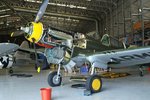Hohun
Yes I found that quite interesting too. It makes sense with the limited room on a carrier but it didn't seem to be a concern for the the FAA.
I also think that the merlin 32 powered Seafire that you mentioned in another post, would have sufficient performance to dominate a zero.
These seem contradictory to me Joe.
10:1 you cite is a claim. I don't see how one claim can measure or validate the accuracy of another claim.
Besides Aug 15 '45, Seafires claimed a few other Japanese fighter types without loss (I think the claimed ratio was actually a little higher than 10:1, August 15 was IIRC their only air combat loss), but it's not clear if any of those other a/c were acting as fighters, rather than kamikazes: the Seafires were on defensive CAP missions. For comparison, the FM-2, which was mostly also used for carrier (CVE) defense in late war claimed 18[3] fighter type a/c for 7 air combat losses, 26:1, Sept '44-Aug '45 (Naval Aviation Combat Statistics).
So even if we had enough of a sample to say much about Seafire v Zero (we don't) we'd have to put it in the context of the particular mission (with kamikaze/fighter confusion in some cases) and of 1945 Pac War air combat overall, very different, in many more ways than just tactics, from air combat v a still pretty first string Zero unit like the 202nd AG in 1943.
Slaterat
Yes I found that quite interesting too. It makes sense with the limited room on a carrier but it didn't seem to be a concern for the the FAA.
I also think that the merlin 32 powered Seafire that you mentioned in another post, would have sufficient performance to dominate a zero.
These seem contradictory to me Joe.
10:1 you cite is a claim. I don't see how one claim can measure or validate the accuracy of another claim.
Besides Aug 15 '45, Seafires claimed a few other Japanese fighter types without loss (I think the claimed ratio was actually a little higher than 10:1, August 15 was IIRC their only air combat loss), but it's not clear if any of those other a/c were acting as fighters, rather than kamikazes: the Seafires were on defensive CAP missions. For comparison, the FM-2, which was mostly also used for carrier (CVE) defense in late war claimed 18[3] fighter type a/c for 7 air combat losses, 26:1, Sept '44-Aug '45 (Naval Aviation Combat Statistics).
So even if we had enough of a sample to say much about Seafire v Zero (we don't) we'd have to put it in the context of the particular mission (with kamikaze/fighter confusion in some cases) and of 1945 Pac War air combat overall, very different, in many more ways than just tactics, from air combat v a still pretty first string Zero unit like the 202nd AG in 1943.
Slaterat

